Surface Preparation Services Information
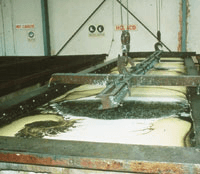 Surface preparation companies use a variety of processes to condition a surface for subsequent coating, plating, or treatment. These suppliers may cleanse a surface of rust, oxide scale, grease, dirt, or oil in order to achieve a surface roughness appropriate for a future application of a coating or other finishing technique.
Surface preparation companies use a variety of processes to condition a surface for subsequent coating, plating, or treatment. These suppliers may cleanse a surface of rust, oxide scale, grease, dirt, or oil in order to achieve a surface roughness appropriate for a future application of a coating or other finishing technique.
Semi-finished parts may demand different levels of surface preparation. For example, a surface that will eventually be painted and requires a glossy appearance must first be finely polished because thin paint will not conceal the underlying roughness. Conversely, a surface that will be thermal spray coated must be prepared with a rough surface, using abrasive blasting, in order to achieve the undercuts necessary for coating to adhere. Without a rough surface thermal spray coatings may pop off or peel under mechanical stress.
The video below describes the preparation of various metal surfaces in anticipation of spray finishing.
Video credit: Brownells Inc. / CC BY-SA 4.0
Surface preparation is closely related to finishing and surface treatment and surface engineering, and all three may use very similar processes and capabilities to achieve different goals.
Finishing and surface treatment suppliers finish part surfaces to achieve desired characteristics, such as roughness. These companies often provide overlapping surface preparation services. Surface treatment may be considered a more "final" step in a manufacturing process.
Surface preparation suppliers, as mentioned above, condition a part surface for further processing; this is an intermediate step in a manufacturing process.
Surface engineering companies modify a surface to enhance a certain property or attribute. For example, a supplier may use a combination of shot peening and polishing to improve the fatigue strength of a shaft.
Surface preparation is the most important step in any coating application process, to the point where most premature coating failures can be traced back to incorrect or inadequate surface preparation.
Finishing Capabilities
Surface preparation companies may be capable of using many different processes and techniques to properly finish a surface. These processes may be used in conjunction depending on the later coating process; for example, a service provider working on a metal product to be galvanized may use caustic cleaning to remove dirt and debris, pickling to remove scale and rust, and fluxing to remove oxides and protect against future oxidization.
Common service capabilities, all described below, include:
- Abrasive finishing
- Anodizing / electroplating
- Deburring / deflashing / pickling
- Oxygen cleaning
- Passivation
- Peening
- Superfinishing / honing
Abrasive Finishing
Abrasive finishing uses power spraying or tumbling to remove rust, paint, and other surface imperfections to improve the adherence of coatings. Additionally, abrasive blasting may be used to smooth a rough surface or roughen a smooth surface for improved coating properties. One of several types of media, including sand, synthetic material, or metal shot, may be used to accomplish this. By using a large vibratory or tumbling chamber, mass finishing of a large number of parts can be accomplished using one process. A special type of abrasive finishing, called abrasive flow machining (AFM), uses abrasive grain to finish the inside of cylindrical parts such as nozzles, fuel injectors, and spray tips. The video below shows the finishing of cylindrical cavities using an AFM process.
Video credit: ExtrudeHone / CC BY-SA 4.0
Anodizing and Electroplating
Anodizing creates a thin protective oxide coating by employing electrolytic oxidation on a metal surface, which simply thickens the part's natural oxide layer. This process preserves the original luster and texture of the part surface while providing it with a hard, durable coating. Anodizing can be combined with other processes such as etching to create part surfaces with different characteristics.
Anodizing involves submerging the metal part (the anode) and a second solid (cathode), often composed of lead, in a solution of electrolytic acid. The anode and cathode are then connected to a DC power source. When current is applied to the part, the water in the acid breaks down, causing oxygen to form at the anode, forming oxide. Both the process and the final part surface are shown below.
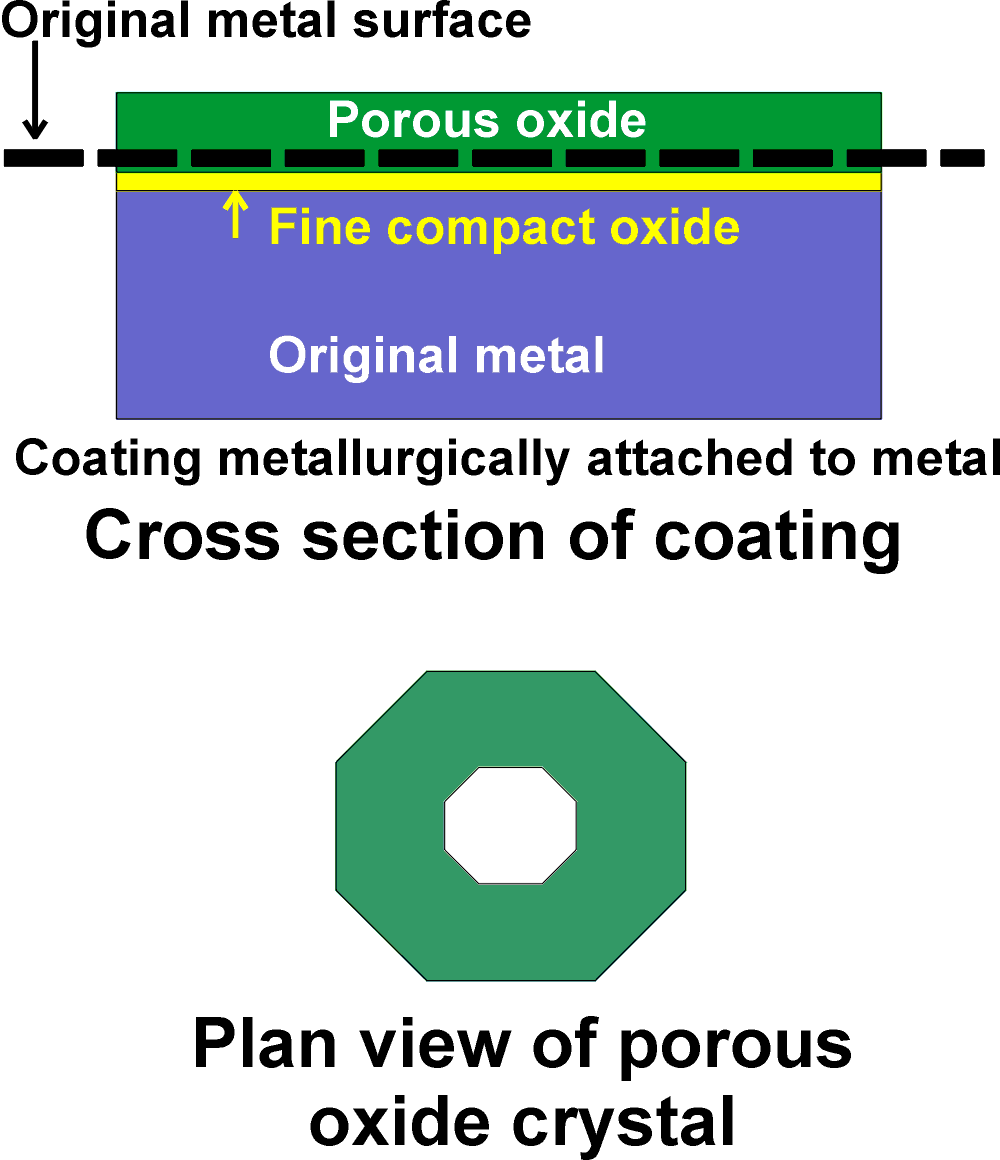
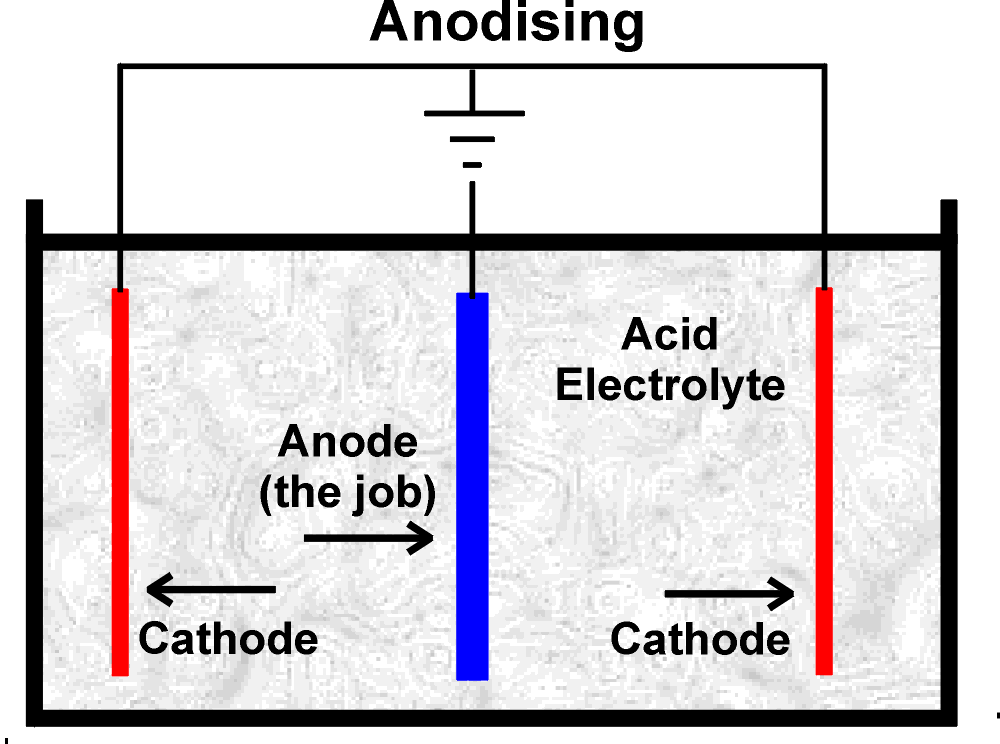
An anodized surface (left) and the anodization process. Image credit: Coatings+Fabrications
Electroplating might be considered the reverse of anodizing. This process is similar in setup but involves treating the part to be finished as the cathode instead of the anode. The anode, which is comprised of the plating material, oxidizes and causes the material to be deposited onto the cathode. The diagram below shows a metal part (Me) plated with copper (Cu). Like anodizing, electroplating is used to improve corrosion resistance, tensile strength, or surface hardness.
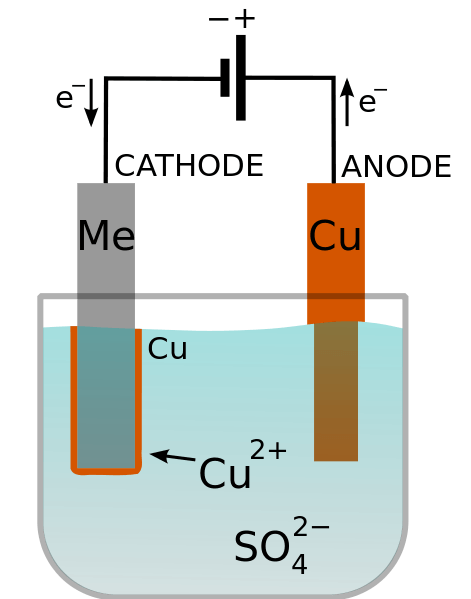
Image credit: Torsten Henning
Deburring, Deflashing, and Pickling
Deburring uses one or several processes to remove burrs, which are small pieces of waste material or sharp corners attached to a manufactured part. Similarly, deflashing is used to remove flash from forged, cast, or molded parts. Both processes can be done manually using electrochemical dissolution, or by using thermal or cryogenic means.
Pickling is a chemical deburring process in which a part is submerged in a strong acid mixture known as a pickle liquor to remove stains, contaminants, rust, and other irregularities. Pickling is commonly used on steel parts, and while it is highly effective for most metals it may cause brittle surfaces and cracking on some alloys. Additionally, traditional pickling results in large amounts of waste products known as pickling sludge, as shown in the image below.
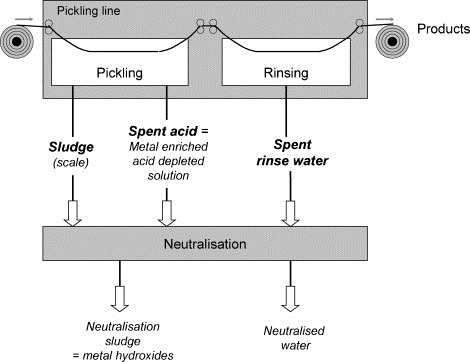
Image credit: ScienceDirect
Oxygen Cleaning
Oxygen cleaning represents a variety of process that remove materials — such as combustible oils, greases, and excess rust — that may explode or ignite when in contact with oxygen. Parts intended for use in or near furnaces, refineries, autoclaves, or thermowells are typically oxygen cleaned for safety.
Passivation
Passivation renders a part surface "passive", meaning more resistant to environmental factors such as air and water, and deposits a light metal oxide shell on the surface. It is frequently used to remove contaminants such as free iron, which contribute to premature corrosion, on stainless steel parts.
Peening
Peening is a mechanical process similar to abrasive blasting that expands a metal's surface to improve its hardness, strength, and some forms of corrosion. The process itself involves shooting glass beads or metal shot at the surface. It is frequently done on shafts and other components exposed to a high number of load cycles. The image below shows the creation of surface dimples using shot peening.
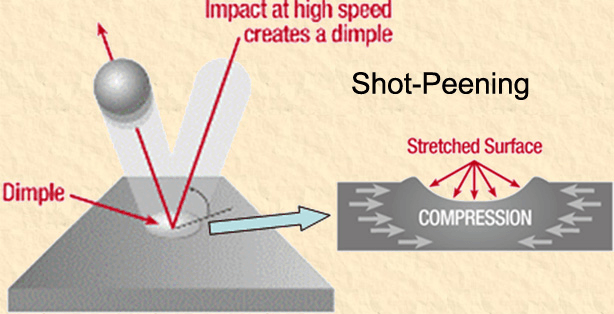
Image credit: Raw4x4
Superfinishing / Honing
Honing and superfinishing are both abrasive processes that involve scrubbing a specialized stone against a part surface. The honing stone, also known as a hone, is made up of abrasive grains bound together using an adhesive and are similar to sharpening stones. The superfinishing process entails oscillation and rotation of the stone to create fine cross-hatching on the part surface; this improves the part's sealing and load bearing capabilities and ultimately extends its functional life. Honing and superfinishing is often done on gears, rollers, transmission components, and bearing spindles.
The image below shows the effects of superfinishing on a magnified part surface. Note the difference between image (a), the basic raw surface, and image (d), which has been superfinished for 20 seconds.
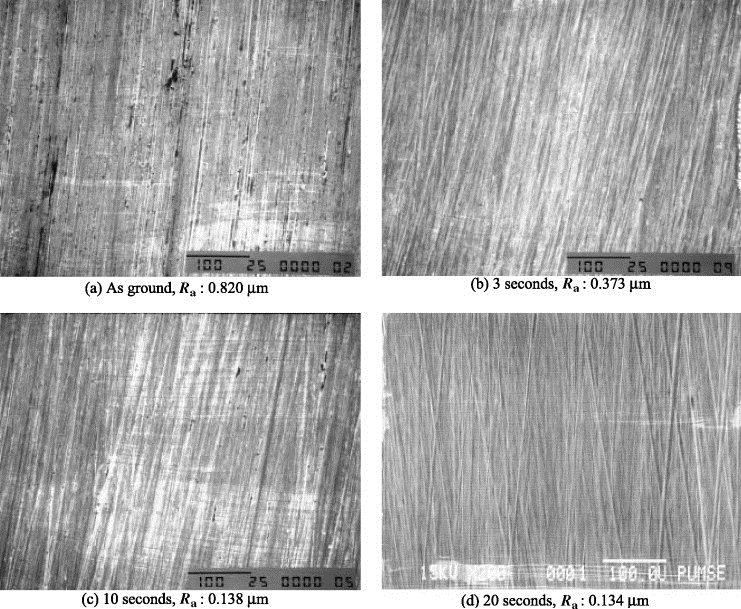
Image credit: ScienceDirect
Other Finishing Techniques
Additional surface finishing capabilities are listed below.
- Buffing and polishing smooths a metal surface for aesthetic or functional purposes.
- Electropolishing is an anodizing process which removes imperfections from a part to form a finely polished surface. Like anodizing, it uses an electrolyte bath and direct current (DC) to dissolve surface flaws.
- Mirror finishing companies are capable of providing a mirror-like reflective part surface.
- Sanding and grinding uses abrasive discs, belts, or wheels to remove surface irregularities.
- Sealing and impregnation services use various techniques to drive resins or coating materials into surfaces to seal open pores. A specific type, vacuum-pressure impregnation (VPI), uses a combination of pressure and vacuum to accomplish the sealing of porous castings, powder metal parts, and coil windings.
Cleaning Capabilities
In addition to surface finishing, service providers may offer various means of cleaning and washing parts to create a smooth surface suitable for coating or processing.
- Burn-off - using heat to remove surface contaminants
- Degreasing- the use of solvents or vapors to remove grease and other insoluble contaminants
- Plasma cleaning - using plasma to remove a thin layer of a part's surface
- Pressure washing - directing a stream of highly pressurized liquid to remove surface debris
- Restoration - reconditioning damaged components in order to restore them to working condition
- Sanitization - destroys micro-organisms on a part's surface; frequently used on medical components
- Ultrasonic cleaning- use of immersion cleaning tanks which are vibrated at ultrasonic frequencies
Selection Criteria
In addition to the shop capabilities described above, it is important to consider a service provider's material compatibility as well as their location.
It is in the best interest of the buyer to match their part material to a shop's material specialties, if they are offered. Surface preparation companies may specialize in one or many part materials, including:
- Ceramics (ie. clay)
- Composites
- Glass
- Metals (aluminum, carbide, copper, iron, nickel, steel, titanium)
- Plastics
- Wood
Additionally, to reduce potential shipping costs and logistical difficulties, buyers may specify a preferred service provider location. Using Engineering360's SpecSearch, users can find shops in various U.S. regions, Canada, Europe, or Asia / Pacific.
Standards
Surface preparation service providers may comply with one or many standards. The finishing industry itself is subject to a rich assortment of standards dependent on the finishing process, workpiece material, and part type. For example, AGMA 06FTM02 is titled "Isotropic superfinishing of main transmission gears."
The ISO 9000 series documents are broad standards adopted to ensure quality products, business principles, and manufacturing techniques. Manufacturers and other job shops may be ISO 9000/9001 certified by one of numerous third-party agencies. Suppliers may seek certification to achieve improved operational or financial performance, customer confidence, and new business. The chart below details a typical quality management system as described by ISO 9000.
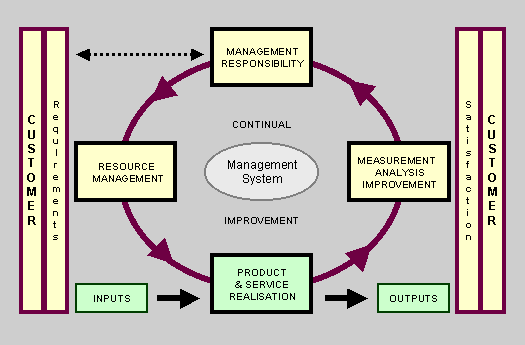
Image credit: Quality Factors
ISO 9000 standards include:
- ISO 9000 : Quality management systems - fundamentals
- ISO 9001 : Quality management systems - requirements / certification
- ISO 9004 : Business principles
Resources
Connecticut Galvanizing - Surface Preparation for Galvanizing
- Abrasive / Blasting
- Aluminum
- Anodizing
- Buffing / Polishing
- Burn-off / Thermal Cleaning
- Carbide
- Ceramic
- Composites
- Copper / Copper Alloys
- Deburring / Deflashing
- Degreasing
- Electropolishing
- Europe Only
- Honing / Superfinishing
- Inspection / Monitoring
- Iron / Cast Iron
- Mass Finishing (Tumbling / Vibratory)
- Material Selection / Design Assistance
- Metal
- Mirror Finishing
- New / OEM Parts
- Nickel / Nickel Alloys
- North America
- Northeast US Only
- On-site / Field (Large Structures)
- Passivation
- Pickling / Chemical Deburring
- Precious Metals
- Pressure / Spray Washing
- Recoating / Refinishing
- Research & Development
- Sanding / Grinding
- Scrub Tank / Immersion Washing
- Southern US Only
- Material / Substrate Capabilities: Specialty / Other
- Stainless Steel
- Steel / Steel Alloys
- Stripping / Coating Removal
- Titanium
- United States Only
